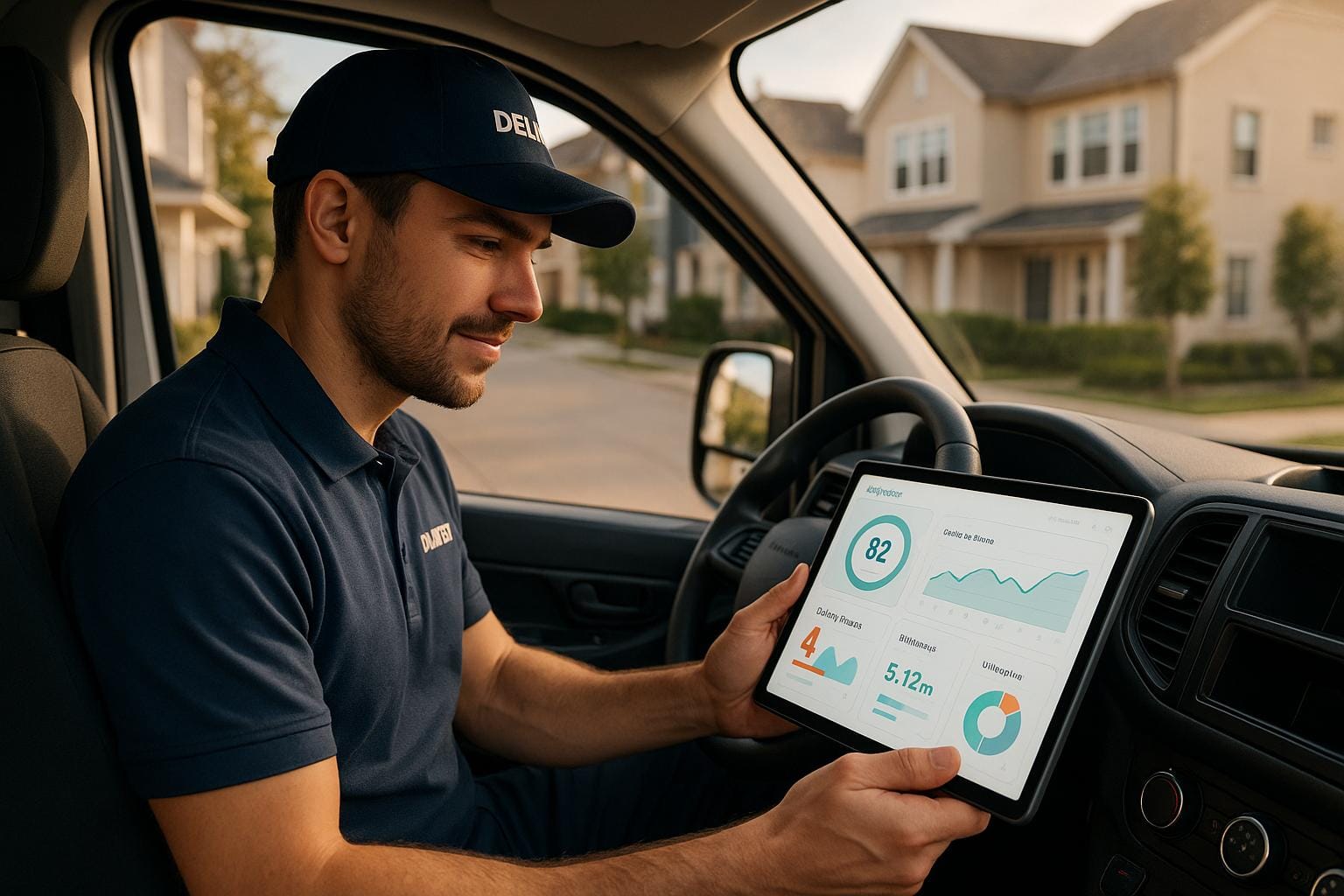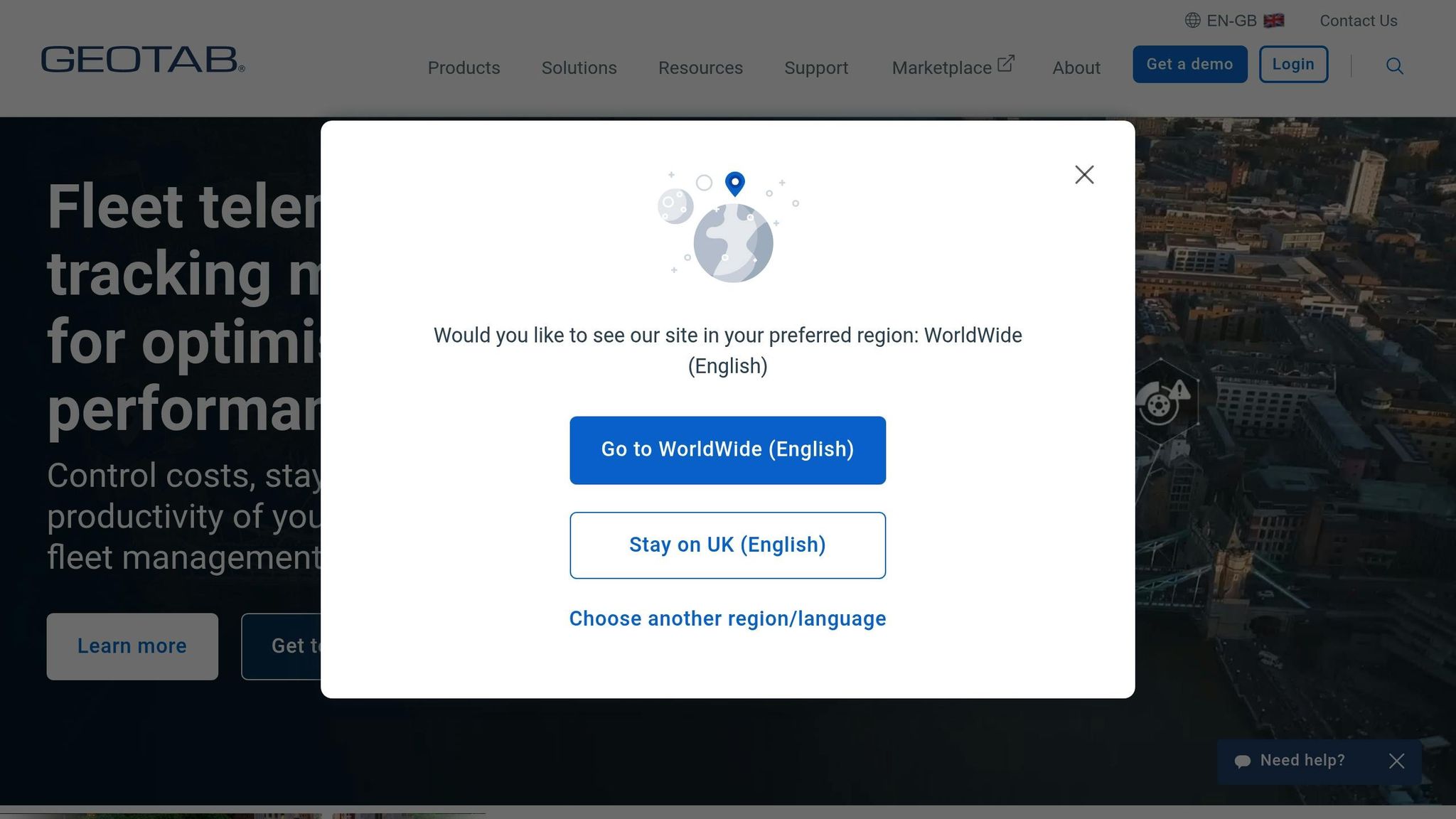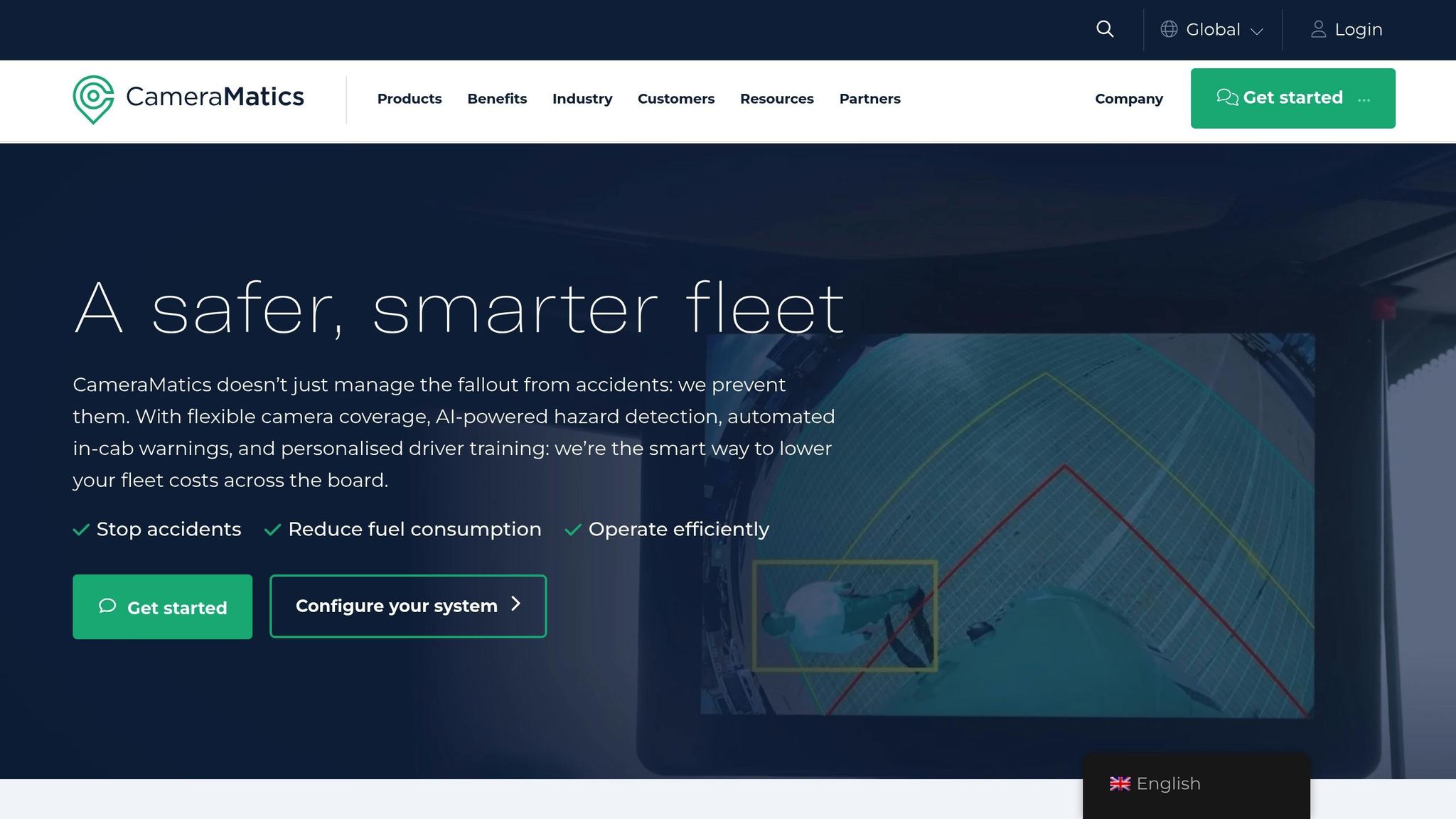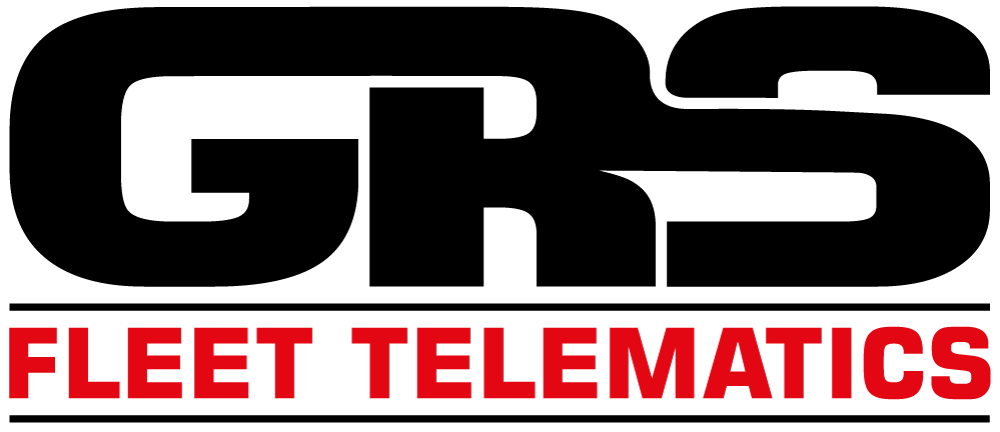Telematics Tools for Tracking Driver Performance in Last-Mile Delivery
Explore how telematics tools enhance driver performance, improve safety, and reduce costs in last-mile delivery operations.

Telematics systems are transforming last-mile delivery by improving driver safety, cutting costs, and boosting efficiency. These tools combine GPS, sensors, and data analytics to monitor vehicle locations, driving behaviours, and fuel usage in real time. For UK fleets, this is crucial as urban congestion, high delivery costs (up to 53% of total shipping costs), and safety concerns (38% of collisions in urban areas during peak times) demand better solutions.
Key Takeaways:
- Safety Improvements: Platforms like Driver•i and CameraMatics reduce accidents by monitoring risky behaviours and providing in-cab coaching.
- Cost Savings: GRS Fleet Telematics starts at £7.99 per vehicle per month, while systems like Geotab help achieve up to 15% better fuel efficiency.
- Real-Time Tracking: All platforms offer GPS tracking and route optimisation to reduce delays and fuel consumption.
- Custom Features: Geotab excels in data analytics, while CameraMatics integrates AI cameras for advanced safety.
Quick Comparison:
| Platform | Starting Cost | Key Features | Best For |
|---|---|---|---|
| GRS Fleet Telematics | £7.99/month | Affordable tracking, theft prevention | Small fleets on tight budgets |
| Geotab | Varies | Real-time data, integrations, route tools | Large fleets needing analytics |
| Driver•i | Higher cost | AI-driven safety, gamified driver scoring | Safety-focused operations |
| CameraMatics | High setup cost | AI cameras, collision avoidance | Urban fleets prioritising safety |
Telematics is a game-changer for fleets of all sizes. Whether you need basic tracking or advanced analytics, choosing the right platform can improve safety, reduce costs, and streamline operations.
How to organize and track your fleet's Driver Behavior Data | Understanding Fleet Data
1. GRS Fleet Telematics
GRS Fleet Telematics brings decades of fleet management expertise to the table, offering a tailored solution for UK businesses aiming to improve their last-mile delivery operations. With advanced vehicle tracking and driver performance monitoring, it’s designed to meet the unique challenges of urban logistics.
Real-Time Tracking
This system delivers constant GPS monitoring, giving fleet managers a clear view of vehicle locations and delivery progress. This real-time insight is invaluable, especially in busy urban areas where traffic conditions can shift unexpectedly. Dispatchers can quickly recommend alternative routes to keep deliveries on schedule.
Additionally, the platform provides detailed journey analytics, comparing planned routes to actual ones. These insights not only highlight patterns in driver behaviour but also pinpoint inefficiencies in routing. Over time, this data helps streamline deliveries and cut down on unnecessary mileage, while also contributing to driver safety.
Driver Safety Monitoring
GRS Fleet Telematics takes driver safety seriously by tracking key behaviours like speeding, harsh braking, rapid acceleration, and sharp cornering. Using geofencing technology, it sets virtual boundaries, sending alerts if vehicles stray outside designated zones or exceed speed limits.
The system also includes eco-driving analytics, which identify fuel-efficient driving habits. This data can be used to create targeted coaching programmes, reducing fuel consumption and vehicle wear while promoting safer driving practices overall.
Security and Theft Prevention
Beyond safety, the platform offers robust security features to tackle vehicle theft. Its dual-tracker technology provides an extra layer of protection, achieving an impressive 91% recovery rate for stolen vehicles. Features like remote immobilisation and 24/7 recovery support further enhance security.
The system also includes theft prevention alerts, notifying managers if a vehicle moves outside set boundaries. This proactive approach helps detect and deter potential theft attempts before they escalate.
Cost Efficiency
GRS Fleet Telematics offers a cost-effective solution for fleet operators, starting at just £7.99 per vehicle per month. This subscription covers SIM card data, full platform access, and dedicated account management, eliminating hidden fees.
Fleet managers can select from three hardware options based on their requirements:
- Essential (£35): Basic real-time tracking
- Enhanced (£79): Primary tracker with Bluetooth backup
- Ultimate (£99): Dual trackers with immobilisation
The pay-per-recovery model ensures businesses only pay recovery fees when needed. Plus, free installation is available when paired with fleet branding through GRS Fleet Graphics. Detailed driver behaviour reports can also demonstrate a commitment to safety, potentially leading to lower insurance premiums.
2. Geotab

Geotab is a telematics platform designed to provide real-time GPS updates and actionable data insights, helping businesses streamline last-mile deliveries in bustling urban settings.
Real-Time Tracking
Geotab offers real-time GPS tracking, enabling fleet managers to compare planned routes with actual ones to enhance efficiency. This feature allows for dynamic dispatching, where new deliveries can be assigned based on drivers' current locations and available capacity. Managers can also monitor delivery progress closely, ensuring they provide customers with accurate estimated arrival times.
Driver Safety Monitoring
Beyond location tracking, Geotab places a strong emphasis on driver safety. The platform's real-time monitoring system flags risky behaviours like speeding, harsh braking, and sharp cornering, triggering immediate alerts and coaching opportunities. Driver scorecards help pinpoint team members who may need additional training, while in-vehicle feedback - via buzzer alerts or spoken instructions - offers instant guidance. Dash cameras integrated into the system not only discourage unsafe driving but also provide valuable evidence for handling insurance claims.
"MyGeotab's unified view of individual and organisational data and insights helps PepsiCo TR proactively manage risks, improve our metrics, elevate safety culture and promote care for our drivers and other road users." – Deniz Tuna, Sales and Fleet Health and Safety Manager, PepsiCo TR
The results speak for themselves: Plastic Express reduced safety alerts by 13%, Tolt Solutions cut accident rates by 21%, Team Goliath Inc. (operating as Domino's Pizza) saved over £80,000 annually on insurance costs, and euroloo eliminated false insurance claims entirely.
Route Optimisation
Geotab's 'Optimize' feature is a game-changer for planning routes. It adjusts to last-minute cancellations and emergencies, ensuring time and fuel savings while increasing overall route efficiency. Customers in field services report savings of 20–55% compared to traditional planning models. Large operators have seen dramatic improvements - Ferrovial reduced its required routes by 66%, and Dipesa Group lowered fuel consumption by 20%.
Cost Efficiency
By optimising routes, Geotab helps businesses significantly cut operational costs. The platform's cost-saving tools, combined with real-time management through the Geotab Drive app, empower drivers with GPS tracking, job management, and instant dispatcher updates to improve service times. Additionally, Geotab supports sustainability efforts by reducing fuel consumption and CO₂ emissions while offering tools to assess the feasibility of transitioning to electric vehicles.
3. Driver•i

Driver•i uses AI and edge computing to analyse video in real time, making it especially useful for last-mile delivery operations where keeping an eye on driver performance and ensuring safety are top priorities.
Real-Time Tracking
Driver•i includes real-time GPS tracking as part of its delivery software, allowing fleet managers to monitor driver locations and delivery progress continuously. It also accounts for external factors like traffic patterns and weather conditions, providing managers with up-to-the-minute information for better route planning. Its dynamic route optimisation feature ensures drivers stay updated on real-time changes, which is crucial for streamlining the last-mile delivery process.
"Driver•i is a comprehensive platform that streamlines last-mile delivery operations. It offers features such as positive driver performance scoring and real-time GPS tracking."
These tracking tools integrate seamlessly with Driver•i's advanced safety monitoring system.
Driver Safety Monitoring
Driver•i takes safety a step further with advanced analytics powered by AI. Its safety monitoring system provides actionable insights for both drivers and fleet managers. By capturing 100% of driving time, the system ensures a complete understanding of every situation. It identifies risky behaviours like distracted driving - whether caused by drowsiness or texting - and issues immediate in-cab audio alerts for dangers such as unsafe following distances. With an impressive 99% accuracy rate, Driver•i has proven its reliability in real-world scenarios.
Major companies like Knight Transportation and Swift Transportation have adopted Driver•i. David Tillman, SVP Safety & Driver Development, shared:
"At Knight Transportation and Swift Transportation, safety is a top priority, and Netradyne's unmatched investment in cutting-edge AI technology made them the clear choice for our fleets. The in-cab audio alerts and real-time feedback are unique tools that empower our drivers to make safer decisions on the road."
John Elliott, CEO of Load One Transportation & Logistics, also highlighted its impact:
"There's no question we can look at our accident rates before we had the cameras and then after and see a direct correlation in the reduction of accidents and the number of incidents. We started seeing dramatic numbers changing within months."
Driver•i introduces GreenZone, a scoring system that rewards positive driving behaviours instead of focusing on penalties. This gamified approach has been highly effective, with over 98 million DriverStars awarded and more than 20 billion driving miles analysed. According to Netradyne, this system can reduce distracted driving by up to 67% .
The insights generated not only improve immediate safety but also contribute to long-term fleet management strategies.
Route Optimisation
Driver•i's route optimisation features use advanced algorithms to boost efficiency by factoring in traffic conditions, vehicle capacity, and delivery time windows. The system adapts to real-time changes, suggesting alternate routes to avoid delays. By identifying the best paths for deliveries, it helps cut down on driving distances, fuel consumption, and vehicle wear and tear. This ability to adjust routes on the fly makes it a valuable tool for navigating the challenges of urban logistics.
Cost Efficiency
Driver•i's gamified approach has delivered measurable results. Randy Sheltra, EVP of Risk Management at Loomis, noted:
"I can tell you what makes the Netradyne system work is that it is gamified. We leaned heavily on that aspect and when paired with incentives for top performers, the result was no preventable accidents."
Additionally, Driver•i automates data collection and simplifies workflows, helping fleets stay compliant with HOS, DVIR, and IFTA regulations. By reducing administrative tasks and improving compliance rates, Driver•i helps fleets manage operations, enhance safety, and meet FMCSA requirements - all in one platform.
4. CameraMatics

CameraMatics tackles the challenges of last-mile delivery by blending AI-driven camera technology with telematics. This combination gives fleet managers a live feed of vehicle locations and driver activities in real time.
Building on insights from earlier platforms, CameraMatics uses advanced imaging technology to take fleet monitoring to the next level.
Real-Time Tracking
With CameraMatics, fleet managers gain access to real-time GPS tracking, mileage data, and geofencing capabilities, alongside live video monitoring. The system alerts managers to unexpected stops or deviations from planned routes . Additionally, it incorporates real-time traffic updates and vehicle insights, enabling operators to assign better routes and quickly adapt to disruptions.
Chris Lively, Fleet Director at C.W. Wright, shared his experience with CameraMatics:
"CameraMatics was the only company that listened to our needs and structured what we needed accordingly. We chose CameraMatics for their adaptability, scalability, and partnership."
These real-time capabilities lay the groundwork for improved safety measures, as explored below.
Driver Safety Monitoring
The platform’s AI-powered system is designed to identify risky driving behaviours and provide immediate in-cab alerts. By using driver-facing cameras, it monitors head position and eye movement to detect signs of fatigue, distraction, or mobile phone use. When such behaviours are identified, drivers receive instant audible warnings. Fleet managers can customise alert settings to reduce unnecessary notifications, and the system records incidents like harsh braking, rapid acceleration, and speeding. These recordings can then be used to create tailored driver training programmes .
Another standout feature is the Intelligent Driver Assistance System (i-DAS), which employs deep learning to detect pedestrians, cyclists, and hidden road users while ignoring irrelevant objects. Additionally, internal cameras track driver fatigue and distraction, offering both audible and visual feedback.
Mervyn O'Callaghan, CEO and Founder of CameraMatics, highlighted the system’s capabilities:
"We're proud to introduce the world's most advanced collision avoidance system, which continues our history of launching disruptive and cutting-edge AI-based technologies within the telematics and fleet management industry. i-DAS provides drivers with a whole new level of awareness when it comes to flagging hazards, fatigue and distractions, helping to reduce avoidable accidents and lowering insurance premiums. More importantly, i-DAS can help to make roads safer for all."
CameraMatics reports that its safety system can lower accident rates by up to 45%.
Route Optimisation
By integrating AI-powered imaging with telematics data, CameraMatics enhances route planning. Its real-time GPS tracking, geofencing, and intelligent route analytics empower operators to make informed decisions. The platform analyses telematics data - such as fuel consumption, mileage, and route performance - to identify opportunities for more efficient service delivery.
Vincent McCarthy from Mr. Binman shared how real-time visibility has benefited his operations:
"The reason that we wanted CameraMatics was that it is real-time, it's over air and we can see the trucks from the minute they go out in the morning until they come back in the yard in the evening."
Cost Efficiency
CameraMatics also delivers cost savings by improving driver performance and fuel efficiency. For example, McCulla Refrigerated Transport increased fleet MPG by 3%, resulting in annual savings of £70,000–£80,000. By working seamlessly with existing telematics systems, the platform can help reduce fuel costs by as much as 15–20%. This enhanced operational visibility not only optimises fleet performance but also addresses some of the most pressing challenges in last-mile delivery.
Advantages and Disadvantages
Fleet managers in the UK have to weigh the pros and cons of various telematics platforms, ensuring they align with their operational needs and budgets.
| Platform | Key Advantages | Primary Disadvantages |
|---|---|---|
| GRS Fleet Telematics | Affordable at £7.99/month; 91% vehicle recovery rate; dual-tracker technology; free installation with fleet branding; immobilisation feature | Limited to core tracking and basic safety features; fewer advanced analytics options |
| Geotab | Extensive data analytics; broad third-party integrations; scalable for large operations | Requires dedicated analysis resources; steep learning curve for smaller fleets |
| Driver•i | AI-driven safety monitoring; real-time driver coaching; advanced collision avoidance | Higher cost; initial overwhelm for drivers due to frequent alerts |
| CameraMatics | Reduces accidents; real-time video monitoring; intelligent driver assistance system (i-DAS) | High setup costs; potential privacy concerns due to camera monitoring |
These comparisons pave the way for a deeper dive into how cost, safety, and operational factors influence platform selection.
Cost Considerations
Costs vary significantly across platforms. For instance, GRS Fleet Telematics stands out with its low monthly fee of £7.99. Despite its affordability, some fleets using telematics report annual fuel savings of 10%–15%, showing that even budget options can deliver meaningful operational benefits.
Safety Performance
Safety is a major factor for fleet operators. Studies reveal that implementing telematics can cut crash rates by 37%–50% and reduce speeding incidents by 15%–80%. This highlights the importance of prioritising safety features, particularly for last-mile delivery operations where risks are higher.
Challenges in Adoption
Adopting telematics technology isn’t without hurdles. Many fleet managers face difficulties interpreting data and navigating platform limitations. Smaller fleets, in particular, often lack IT support, making simpler platforms like GRS Fleet Telematics more appealing.
Driver acceptance also plays a critical role. While telematics can sometimes cause stress or reduce trust among drivers, thoughtful implementation can turn it into a tool for recognising safe driving behaviours and reducing risky habits.
Operational Savings
Telematics can also have a big impact on efficiency. By identifying inefficient driving habits, fleets can achieve up to 30% in fuel savings. A notable example is UPS, which saved 10 million gallons of fuel in a single year by optimising delivery routes.
Integration and Scalability
Integration capabilities differ widely. Geotab excels in third-party connectivity, making it ideal for fleets with complex needs. On the other hand, GRS Fleet Telematics focuses on simple, seamless installation for core tracking. Platforms like CameraMatics, with features such as real-time video monitoring, offer advanced functionalities but may require more technical know-how to maximise their benefits.
Scalability is another key factor. Smaller fleets often find GRS Fleet Telematics’ straightforward approach more manageable. In contrast, larger operations may benefit from Geotab’s robust data management capabilities. Mixed fleets often prefer aftermarket solutions, which avoid the constraints of OEM telematics systems.
Insurance Savings
Telematics can also lead to substantial insurance savings. Some operators have reported premium reductions of up to £60,000, along with a 66% drop in accidents within six months. With car insurance costs rising by 52% over the past three years, these savings are becoming increasingly critical for fleet operators in the UK.
Final Recommendations
Selecting the right telematics solution for your last-mile delivery operations requires a clear understanding of your business priorities, including your budget, fleet size, and operational needs.
For small to medium-sized fleets working within tight budgets, GRS Fleet Telematics offers essential security and tracking features at an affordable price. This system provides the basics - such as theft protection and vehicle tracking - without unnecessary complexity.
If budget constraints are a concern, focus on solutions that provide immediate, measurable benefits. Telematics systems have a proven track record of improving safety and streamlining operations, which often translates into noticeable insurance savings. Prioritise core functionalities over advanced features that may require additional IT resources and expertise to manage.
For larger fleets with more intricate operational requirements, platforms like Geotab are ideal. These systems shine when it comes to data analytics and integrating with third-party tools. While they might involve a steeper learning curve, the payoff can be significant. For instance, PepsiCo reported a 70% reduction in collisions after implementing Geotab’s solutions. If your organisation has the resources to manage these advanced platforms, they can offer unparalleled insights and efficiencies.
For fleets operating in urban areas, where safety risks are higher, investing in systems with real-time coaching and collision avoidance features is crucial. This is especially relevant given that 38% of road collisions in the UK during 2022 occurred in urban areas during peak delivery times. Such features can actively help reduce high-risk behaviours among drivers, improving both safety and operational performance.
No matter the platform, driver buy-in is essential. Ensure your drivers see the system as a tool for improvement rather than surveillance. Using telematics to reward safe driving can encourage positive engagement. Start with a pilot programme on a small segment of your fleet to test the system’s impact on fuel efficiency, maintenance costs, and safety incidents. This approach provides valuable data for calculating ROI and identifying the features that will be most beneficial for your operations.
Ultimately, the best telematics solution is one that aligns with your fleet’s size and technical capabilities. For straightforward needs, simple and affordable options like GRS Fleet Telematics are a perfect fit. But for operations requiring detailed analytics and complex integrations, more advanced platforms are worth the investment. By tailoring your choice to the demands of urban logistics and your specific business goals, you can enhance both efficiency and safety across your fleet.
FAQs
How can telematics tools improve driver safety in last-mile delivery operations?
Telematics tools are a game changer when it comes to boosting driver safety in last-mile delivery. These systems monitor driving behaviours like speeding, harsh braking, and sharp cornering, giving fleet managers the insights they need to spot risky habits. With this data, they can offer tailored training that encourages safer driving practices.
Real-time GPS tracking adds another layer of protection by providing live updates on driver locations and road conditions. This means fleet managers can respond swiftly to potential hazards or emergencies. By promoting safer driving habits and enabling quick action when needed, telematics tools play a crucial role in cutting down accidents and improving safety across last-mile delivery operations.
How can telematics systems help reduce costs for fleet operators?
Telematics systems offer a practical way for fleet operators to cut costs by improving fuel efficiency, streamlining maintenance schedules, and making better use of vehicles. These enhancements not only help lower operational expenses but also contribute to more efficient daily operations.
On top of that, telematics can help reduce insurance premiums by encouraging safer driving habits and providing detailed incident data. Features like real-time van tracking and theft prevention tools add an extra layer of security, helping businesses mitigate the financial risks associated with vehicle theft. With prices starting at just £7.99 per month, telematics systems provide an affordable solution for boosting fleet efficiency and cutting costs.
How can telematics systems help overcome the unique challenges of urban delivery operations?
Telematics systems play a key role in transforming urban delivery operations by offering real-time vehicle tracking and route optimisation. These features help drivers dodge traffic jams and complete deliveries faster, making the last-mile process more efficient and reliable.
On top of that, telematics generates valuable data insights that aid in smarter inventory management and predictive planning. Businesses can cut down on idle time and fine-tune their operations, which means fewer wasted resources and lower fuel consumption. This not only improves efficiency but also promotes greener, more sustainable urban logistics.
